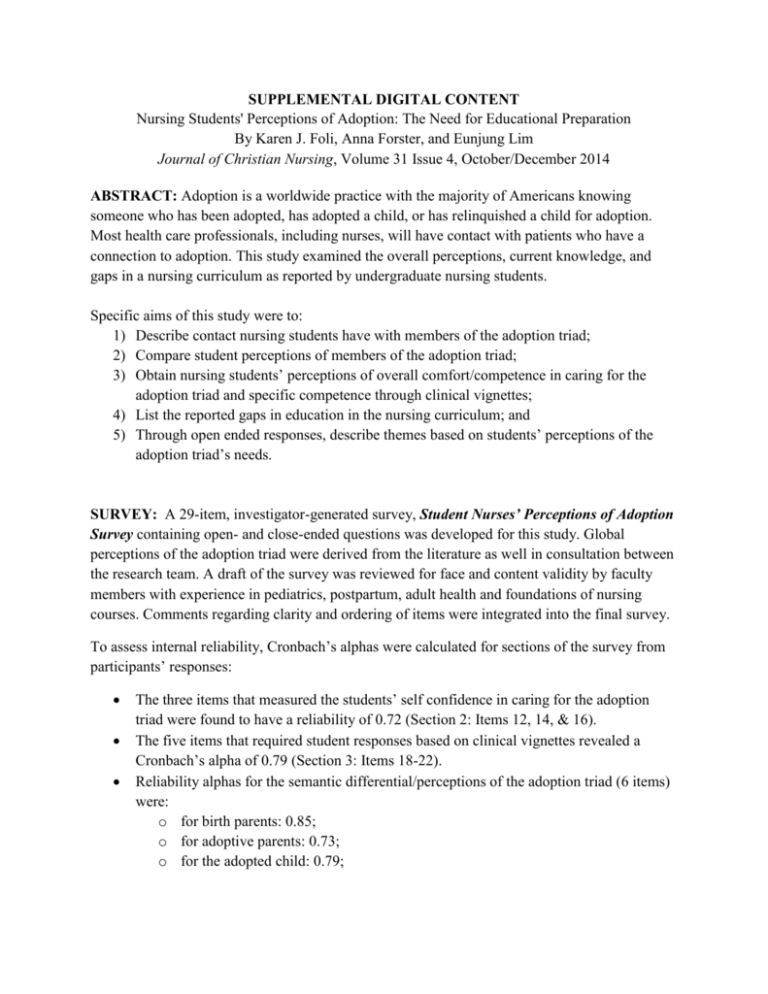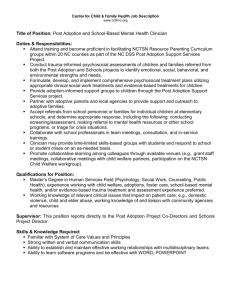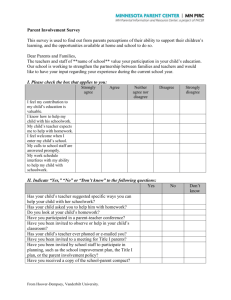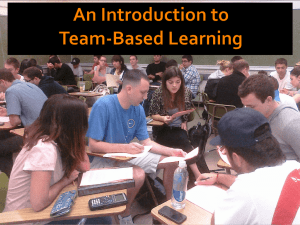Undergraduate Students` Perception of Adoption Triad
advertisement

SUPPLEMENTAL DIGITAL CONTENT Nursing Students' Perceptions of Adoption: The Need for Educational Preparation By Karen J. Foli, Anna Forster, and Eunjung Lim Journal of Christian Nursing, Volume 31 Issue 4, October/December 2014 ABSTRACT: Adoption is a worldwide practice with the majority of Americans knowing someone who has been adopted, has adopted a child, or has relinquished a child for adoption. Most health care professionals, including nurses, will have contact with patients who have a connection to adoption. This study examined the overall perceptions, current knowledge, and gaps in a nursing curriculum as reported by undergraduate nursing students. Specific aims of this study were to: 1) Describe contact nursing students have with members of the adoption triad; 2) Compare student perceptions of members of the adoption triad; 3) Obtain nursing students’ perceptions of overall comfort/competence in caring for the adoption triad and specific competence through clinical vignettes; 4) List the reported gaps in education in the nursing curriculum; and 5) Through open ended responses, describe themes based on students’ perceptions of the adoption triad’s needs. SURVEY: A 29-item, investigator-generated survey, Student Nurses’ Perceptions of Adoption Survey containing open- and close-ended questions was developed for this study. Global perceptions of the adoption triad were derived from the literature as well in consultation between the research team. A draft of the survey was reviewed for face and content validity by faculty members with experience in pediatrics, postpartum, adult health and foundations of nursing courses. Comments regarding clarity and ordering of items were integrated into the final survey. To assess internal reliability, Cronbach’s alphas were calculated for sections of the survey from participants’ responses: The three items that measured the students’ self confidence in caring for the adoption triad were found to have a reliability of 0.72 (Section 2: Items 12, 14, & 16). The five items that required student responses based on clinical vignettes revealed a Cronbach’s alpha of 0.79 (Section 3: Items 18-22). Reliability alphas for the semantic differential/perceptions of the adoption triad (6 items) were: o for birth parents: 0.85; o for adoptive parents: 0.73; o for the adopted child: 0.79; o for all three triads (18 items): 0.80 (see Section 4 of the survey). The online survey which students responded to was created through Qualtrics, web-based survey software. ANALYSIS: Descriptive statistics (frequencies, means, standard deviations) were computed to address Aims 1 and 4. To investigate students’ perceptions of members of the adoption triad, we performed analyses of covariance (ANCOVA) by a mixed model approach by controlling for students’ clinical interests and clinical experience (Aim 2). Tukey’s post-hoc tests were then utilized to compare mean differences between students’ perceptions of members of the adoption triad. To compare students’ perceptions of competence in caring for the adoption triad through clinical vignettes, paired t-tests were conducted (Aim 3). All analyses were performed using Statistical Analysis Software (SAS) Version 9.3 (2008, Cary, NC: SAS Institute Inc.) and p < 0.05 was considered statistically significant. Results are shown in three tables (below): 1) Demographic Characteristics of Student Participants 2) Undergraduate Students’ Perception of Adoption Triad 3) Self-confidence on Clinical Situations Related to Adoption Triad Nursing Students’ Perceptions of Adoption: Survey Tool © Karen J. Foli, PhD, RN, Anna Forster, & Eunjung Lim, PhD For permission to use this tool in research, please contact Karen Foli at kfoli@purdue.edu Section 1: Demographics and Previous Experiences 1. What is your gender? A. Male B. Female C. Other (transgender or intersexual) D. Decline to Answer 2. What is your age? A. 18 years B. 19 years C. 20 years D. 21 years E. 22 years F. 22-24 years 3. What state were you born in? 4. Which racial or ethnic group do you most closely identify with? A. Caucasian or White American B. Native American C. Hispanic American D. Asian American/Pacific Islander E. Bi-racial or multi-racial F. Other G. Prefer not to answer 5. What year in school are you? A. Freshman B. Sophomore C. Junior D. Senior 6. Did you enter the School of Nursing_____________ A. Directly from high school B. As a CODO (transfer from another major) C. From another college/university 7. In general, how spiritual would you say you are? Are you… A. Very spiritual B. Somewhat spiritual C. Not very spiritual D. Not at all spiritual E. Not sure 8. I have clinical experience outside of my nursing education (check all that apply) A. As a Certified Nursing Assistant (CAN) B. During the summer(s) as a nurse extern C. Other_________________ D. No experience 9. What clinical areas interest you (check all that apply)? A. Critical Care B. Emergency Department C. Labor, Delivery or postpartum unit D. Pediatrics E. Psychiatric/mental health F. Operating Room/Recovery Room G. Medical/Surgical nursing H. Public/Community health I. Other_______________ 10. As a student nurse, in the past year, I have delivered care to (check all that apply): A. Birth Parents B. Adoptive Parents C. Children who are adopted D. Adults who are adopted E. None of the above F. Don’t know 11. Are you (check all that apply)…… A. A member of an extended family that includes an individual who is adopted B. A friend of a person who is adopted C. A member of an adoptive family D. A person who was adopted E. A birth parent F. None of the above G. Decline to answer ________________________________ Section 2: Confidence with Caring for the Adoption Triad Again we use the "adoption triad" to describe individuals whose lives have been directly touched by adoption. The members of this triad are the birth parents, who make a decision to relinquish a child; the adoptive parents, who parent the child from the ages of infancy to 17 years of age; and the individual who is adopted. A kinship parent is an individual who is a relative or close family member who has assumed the care of the child. Each of these populations has distinct needs from nurses who render care to them. The following questions pertain to your level of knowledge and comfort as a student nurse who will after graduation, give care to this patient group. 12. I feel comfortable with my level of knowledge/skills in caring for birth parents. A. Strongly Agree B. Agree C. Neither agree nor disagree D. Disagree E. Strongly Disagree 13. What knowledge/skills would be most helpful to you in caring for birth parents? (Open ended) 14. I feel comfortable with my level of knowledge/skills in caring for adoptive parents. A. Strongly Agree B. Agree C. Neither agree nor disagree D. Disagree E. Strongly Disagree 15. What information/skill set would be most helpful to you in caring for the adoptive parents? (Open ended) 16. I feel comfortable with my level of knowledge/skills in caring for children or adults who are adopted. A. Strongly Agree B. Agree C. Neither agree nor disagree D. Disagree E. Strongly Disagree 17. What information/skill set would be most helpful to you in caring for children or adults who are adopted? (Open ended) ____________________________________ Section 3: Clinical Vignettes: Now, we'd like to describe various clinical scenarios that you might encounter as you care for members of the adoption triad. In each case, answer the statement based on patient care within the context of adoption. 18. You are caring for a 26-year-old female who has just miscarried in the 12th week of gestation. She confides to you that she was adopted when she was 2 years of age and is having feelings of abandonment in her marriage. The miscarriage, she confides to you, only adds to these feelings. Please answer the following statement related to her psychosocial needs: "I would know how to implement the nursing process in this situation, including a plan of care with interventions." A. B. C. D. E. Strongly Agree Agree Neither agree nor disagree Disagree Strongly Disagree 19. You are now in your obstetrical clinical rotation and are informed that an adoptive mother wants to be in the delivery room when the birth mother delivers her baby. She informs you that this has been discussed and agreed upon by the birth parents. "I would know how to implement the nursing process in this situation, including a plan of care with interventions." A. Strongly Agree B. Agree C. Neither agree nor disagree D. Disagree E. Strongly Disagree 20. You are in your public health clinical and are following the school nurse at a large high school. A 14-year-old girl arrives at the nursing office complaining of nausea and vomiting. She confides to the nurse (and you) that she is 8 weeks pregnant and considering relinquishing the baby for adoption. "I would know how to implement the nursing process, including a plan of care with interventions." A. Strongly Agree B. Agree C. Neither agree nor disagree D. Disagree E. Strongly Disagree 21. You are in a nurse-managed clinic, shadowing the pediatric nurse practitioner. A couple brings their 12-month old child, who is adopted, in for a well-child check. They express to the PNP and you that they have noticed their 4-year-old biological child is having trouble bonding with the new baby. "I would know how to implement the nursing process, including a plan of care with interventions." A. Strongly Agree B. Agree C. Neither agree nor disagree D. Disagree E. Strongly Disagree 22. Your next rotation is on a medical surgical floor where you are caring for patient with Type 2 diabetes and hypertension. This 55-year-old grandmother has assumed the care of her 2-year-old granddaughter (as a kinship parent). She confides to you that she has been feeling overwhelmed, sad, and isn't able to do the self-care necessary to maintain her health because of the demands of parenting a toddler. "I would know how to implement the nursing process, including a plan of care with interventions." A. Strongly Agree B. Agree C. Neither agree nor disagree D. Disagree E. Strongly Disagree ___________________________________ Section 4: Semantic Differential Descriptors of Adoption Triad This section of the survey asks you to describe members of the adoption triad by descriptors that are antonyms (opposites). 23. For this question, how would you describe an adoptive parent? Click on the button between the adjectives that you think best describes adoptive parents. Happy Responsible Selfless Powerful Stable Supported Sad Irresponsible Selfish Powerless Unstable Not supported 24. For this question, how would you describe a birth parent? Click on the button between the adjectives that you think best describes birth parents. Happy Responsible Selfless Powerful Stable Supported Sad Irresponsible Selfish Powerless Unstable Not supported 25. For this question, how would you describe a child who has been adopted? Click on the button between the adjectives that you think best describes that individual. Happy Responsible Selfless Powerful Stable Supported Sad Irresponsible Selfish Powerless Unstable Not supported 26. For this question, how would you describe an adult who has been adopted? Click on the button between the adjectives that you think best describes that individual. Happy Responsible Selfless Sad Irresponsible Selfish Powerful Stable Supported ________________________________ Powerless Unstable Not supported Section 5: Need for Information and Education 27. More information regarding adoption (how to care for the adoption triad) should be offered during your years spent in nursing education? A. B. C. D. E. Strongly Agree Agree Neither agree nor disagree Disagree Strongly Disagree 28. Which of these topics/educational offerings do you think would be helpful? Check all that apply. A. B. C. D. E. Legalities of adoption Counseling birth parents about adoption Parental postadoption depression Specific needs of the child who is adopted Other topics/educational offerings_______________________________ 29. Please use the space below to include any additional information, such as experiences with birth parents, adoptive parents, and/or children who are adopted or comments that you would like to add. Demographic Characteristics of Student Participants Characteristics Gender Female Male Collage Year Freshman Sophomore Junior Senior Race Caucasian or White Other Perceived Spiritualty Very spiritual Somewhat spiritual Not very spiritual Not at all spiritual Type of Student Directly from high school Internal or external transfer student Clinical Experience* Certified Nursing Assistant Nurse Extern Other None Clinical Interest* Critical care Emergency department Labor, delivery, or postpartum unit Pediatrics Psychiatric/mental health Operating room/recovery room Medical/surgical nursing Public/community health Other Past Experience in Delivering Care* Birth parents Adoptive parents Adopted child Adopted adult None Don’t know n (%) 83 (98%) 2 (2%) 13 (15%) 24 (28%) 19 (22%) 29 (34%) 83 (98%) 2 (2%) 34 (40%) 41 (48%) 8 (9%) 2 (2%) 73 (86%) 12 (14%) 16 (19%) 22 (27%) 18 (22%) 33 (40%) 44 (52%) 39 (46%) 54 (64%) 51 (60%) 11 (13%) 19 (22%) 28 (33%) 14 (17%) 18 (22%) 27 (33%) 6 (7%) 8 (10%) 8 (10%) 26 (32%) 29 (36%) *Multiple answers are possible. Total sample N = 85. Undergraduate Students’ Perception of Adoption Triad Domain Perceived Image Happy: Sad Responsible: Irresponsible Selfless: Selfish Powerful: Powerless Stable: Unstable Supported: Not Supported Perceived Comfort Caring for Triad Knowledge Birth Parents Adoption Triad Adoptive Parents BP vs. AP p* BP vs. AC Adopted Children AP vs. AC 2.77 ± 1.06 3.00 ± 0.94 3.65 ± 0.95 2.87 ± 0.88 2.56 ± 0.98 2.73 ± 1.09 4.43 ± 0.70 4.59 ± 0.64 4.09 ± 0.75 3.54 ± 0.77 4.32 ± 0.64 4.29 ± 0.65 3.55 ± 0.78 3.49 ± 0.71 3.31 ± 0.70 3.16 ± 0.64 3.38 ± 0.75 3.84 ± 0.75 <.0001 <.0001 .005 <.0001 <.0001 <.0001 <.0001 .0002 .033 .104 <.0001 <.0001 <.0001 <.0001 <.0001 .005 <.0001 .003 3.60 ± 0.95 3.25 ± 0.83 3.51 ± 0.84 .001 .554 .024 n = 80. The possible range was 1=strongly disagree to 5=strongly agree (scores are reversed from the original scale). AP = Adoptive Parents. BP = Birth Parents. AC = Adopted Children. *Tukey’s post-hoc test was performed. Self-confidence on Clinical Situations Related to Adoption Triad Mean ± SD* #1 #2 #3 #4 #5 Vignette Miscarriage Delivery Pregnancy Bonding Kin Parent n 83 82 81 81 81 3.04 ± 0.99 3.57 ± 0.88 3.43 ± 0.99 2.93 ± 0.96 3.00 ± 0.95 Self-Confidence in Caring for Birth Parents 3.60 ± 0.95 t p N/A N/A -0.30 .763 -1.39 .167 N/A N/A N/A N/A Self-Confidence in Caring for Adoptive Parents 3.25 ± 0.83 t p N/A N/A 3.24 .002 N/A N/A -3.12 .003 -2.58 .012 Self-Confidence in Caring for Adopted Children/Adults 3.51 ± 0.84 t p -3.87 .0002 N/A N/A N/A N/A N/A N/A N/A N/A N=81~83. Paired t test was performed (Row minus bottom line of each column). *Same as “Perceived Comfort in Caring for Triad Knowledge” in Table: Undergraduate Students’ Perception of Adoption Triad The possible range was 5=strongly agree to 1=strongly disagree (scores are reversed from the original scale).







